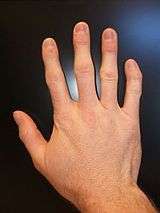Triple X syndrome
Triple X syndrome, also known as trisomy X and 47,XXX, is characterized by the presence of an extra X chromosome in each cell of a female.[1] Those affected are often taller than average.[1] Usually there are no other physical differences and normal fertility.[1] Occasionally there are learning difficulties, decreased muscle tone, seizures, or kidney problems.[1]
| Triple X syndrome | |
|---|---|
| Other names | Triplo-X syndrome, trisomy X, XXX syndrome, 47,XXX syndrome[1] |
 | |
| Increased distance between the eyes in 9 year old girl with trisomy X[2] | |
| Specialty | Medical genetics |
| Symptoms | Taller than average[1] |
| Complications | Learning difficulties, decreased muscle tone, seizures, kidney problems[1] |
| Causes | Random event[1] |
| Diagnostic method | Chromosomal analysis[3] |
| Treatment | Speech therapy, physical therapy, counseling[3] |
| Frequency | 1 per 1,000 female births[2] |
Triple X is due to a random event.[1] Triple X can result either during the division of the mother's reproductive cells or during division of cells during early development.[2] It is not typically inherited from one generation to the next.[1] A form where only a percentage of the body cells contain XXX can also occur.[1] Diagnosis is by chromosomal analysis.[3]
Treatment may include speech therapy, physical therapy, and counseling.[3] It occurs in about one in every 1,000 female births.[2] It is estimated that 90% of those affected are not diagnosed as they either have no or only few symptoms.[2] It was first identified in 1959.[4]
Signs and symptoms
Because the vast majority of triple X females are never diagnosed, it may be very difficult to make generalizations about the effects of this syndrome. The samples that were studied were small and may be nonrepresentative. Because of the lyonization, inactivation, and formation of Barr bodies in all female cells, only one X chromosome is active at any time. A person with triple X syndrome will have two Barr bodies in each cell, leading to most persons having only mild effects or no effects. The symptoms vary from person to person, with some women being more affected than others.
Physical
Symptoms may include tall stature, vertical skin folds that may cover the inner corners of the eyes (epicanthal folds), poor muscle tone, and a curve in the 5th finger towards the 4th.[2] There may also be a small head (microcephaly).[5] There are seldom any observable physical anomalies in triple X females, other than being taller than average.
Poor coordination may be present.[6] Those affected appear to have higher rates of scoliosis.[6]
 Epicanthal folds and increased distance between the eyes in 2-year-old girl with trisomy X[2]
Epicanthal folds and increased distance between the eyes in 2-year-old girl with trisomy X[2] The type of finger curvature frequently seen in triple X syndrome
The type of finger curvature frequently seen in triple X syndrome
Cause
.svg.png)
.svg.png)
Triple X syndrome is not inherited, but usually occurs as an event during the formation of reproductive cells (ovum and sperm). An error in cell division called nondisjunction can result in reproductive cells with additional chromosomes. For example, an oocyte or sperm cell may gain an extra copy of the X chromosome as a result of the non-disjunction. If one of these cells contributes to the genetic makeup of a child, the child will have an extra X chromosome in each of her cells. In some cases, trisomy X occurs during cell division in early embryonic development.
Some females with triple X syndrome have an extra X chromosome in only some of their cells. These cases are called 46,XX/47,XXX mosaics.
Diagnosis
The vast majority of triple X women are never diagnosed, unless they undergo tests for other medical reasons later in life. Triple X can be diagnosed by a blood test which is able to look at a person’s chromosomes (karyotype). Abnormalities on the electroencephalography may be present.[6]
Triple X syndrome can be diagnosed prenatally through amniocentesis or chorionic villus sampling. In Denmark, between 1970 and 1984, 76% of the prenatally diagnosed fetuses with triple-X were aborted. By 1987, this figure dropped to 56%. With improved information, the number of abortions diminished. In the Netherlands, between 1991 and 2000, 33% (18/54) of the couples that were confronted with a prenatal diagnosis of 47, XXX elected to abort. If balanced information is provided to prospective parents, prenatally, the incidence of voluntary termination (abortion) is reduced.[7]
Treatment
A stable home environment can improve some of the symptoms.[6]
Epidemiology
Triple X syndrome occurs in around 1 in 1,000 girls. On average, five to ten girls with triple X syndrome are born in the United States each day.[8]
History
The first published report of a woman with a 47,XXX karyotype was by Patricia A. Jacobs, et al. at Western General Hospital in Edinburgh, Scotland, in 1959. It was found in a 35‑year-old, 5 ft. 9 in. (176 cm) tall, 128 lb. (58.2 kg) woman who had premature ovarian failure at age 19; her mother was age 41 and her father was 40 at the time of her conception.[9] Jacobs, et al. called the 47,XXX woman a "superfemale", a term which was immediately criticized, did not gain acceptance, and was based on the incorrect assumption that the sex-determination system in mammals was the same as in the fruit fly Drosophila.[10] British pathologist and geneticist Bernard Lennox, the principal consultant on medical terms for the Oxford English Dictionary, suggested the term "XXX syndrome".[11]
References
- "triple X syndrome". GHR. June 2014. Archived from the original on 27 July 2016. Retrieved 26 September 2016.
- Tartaglia, NR; Howell, S; Sutherland, A; Wilson, R; Wilson, L (11 May 2010). "A review of trisomy X (47,XXX)". Orphanet Journal of Rare Diseases. 5: 8. doi:10.1186/1750-1172-5-8. PMC 2883963. PMID 20459843.
- "47 XXX syndrome". GARD. 16 March 2016. Archived from the original on 5 November 2016. Retrieved 26 September 2016.
- Wright, David (2011). Downs: The history of a disability. OUP Oxford. p. 159. ISBN 9780191619786. Archived from the original on 2017-09-11.
- "Triple X syndrome". Mayo Clinic. August 17, 2010. Archived from the original on 2012-02-28.
- Otter, M; Schrander-Stumpel, CT; Curfs, LM (March 2010). "Triple X syndrome: a review of the literature". European Journal of Human Genetics. 18 (3): 265–71. doi:10.1038/ejhg.2009.109. PMC 2987225. PMID 19568271.
- Schrander-Stumpel C (2005). "Triple-X-Syndrome or Trisomy X" (PDF). Patient Care. 32 (6): 15–21. Archived from the original on 2011-07-24. Retrieved 2010-07-28. English translation from original Dutch by Jill Balfour.
- National Library of Medicine (2007). "Genetics Home Reference: Triple X syndrome". Archived from the original on 2007-03-12. Retrieved 2007-03-22.
- Jacobs, Patricia A.; Baikie, Albert G.; Court Brown, W. Michael; MacGregor, Thomas N.; Maclean, Neil; Harnden, David G. (September 26, 1959). "Evidence for the existence of the human 'super female'". The Lancet. 274 (7100): 423–425. doi:10.1016/S0140-6736(59)90415-5. PMID 14406377.
- Stern, Curt (December 12, 1959). "Use of the term 'superfemale'". The Lancet. 274 (7111): 1088. doi:10.1016/S0140-6736(59)91557-0.
Jacobs, Patricia A.; Baikie, Albert G.; Court Brown, W. Michael; Harnden, David G.; MacGregor, Thomas N.; Maclean, Neil (December 19, 1959). "Use of the term 'superfemale'". The Lancet. 274 (7112): 1145. doi:10.1016/S0140-6736(59)90132-1.
Jacobs, Patricia A. (March 3–5, 2006). "The discovery and history of Trisomy X and XYY syndrome". National Conference on Trisomy X and XYY, UC Davis M.I.N.D. Institute, Sacramento, California. DVD 02. Pine, Colorado: KS&A.
Ferguson-Smith, Malcolm A. (December 2009). "It is 50 years since the discovery of the male determining role of the Y chromosome!". Sexual Development. 3 (5): 233–236. doi:10.1159/000252792. PMID 19844083.
Ferguson-Smith, Malcolm A. (September 2011). "Putting medical genetics into practice". Annual Review of Genomics and Human Genetics. 12: 1–23. doi:10.1146/annurev-genom-082410-101451. PMID 21639797. - Lennox, Bernard (January 2, 1960). "Use of the term 'superfemale'". Lancet. 275 (7114): 55. doi:10.1016/S0140-6736(60)92744-6.
Fraser, Jean H.; Campbell, John; MacGillivray, Ronald Charles; Boyd, Elizabeth; Lennox, Bernard (September 17, 1960). "The XXX syndrome: frequency among mental defectives and fertility". The Lancet. 276 (7151): 626–627. doi:10.1016/S0140-6736(60)91696-2. PMID 13701513.
Anderson, John B.; Crofton, John (August 16, 1997). "Obituary: Bernard Lennox". BMJ. 315 (7105): 432. doi:10.1136/bmj.315.7105.432.